Football/Soccer Session (Advanced): UEFA A Elite Youth Licence - Attackers Attacking in 4-1-4-1
Profile Summary

| Name: | Graham Rennie |
|---|---|
| City: | Morristown |
| Country: | United States of America |
| Membership: | Adult Member |
| Sport: | Football/Soccer |
Description
Attackers attacking in 4-1-4-1
How the movement of the centre forward can get either themself or team mates to penetrate opposing teamd defensive line.
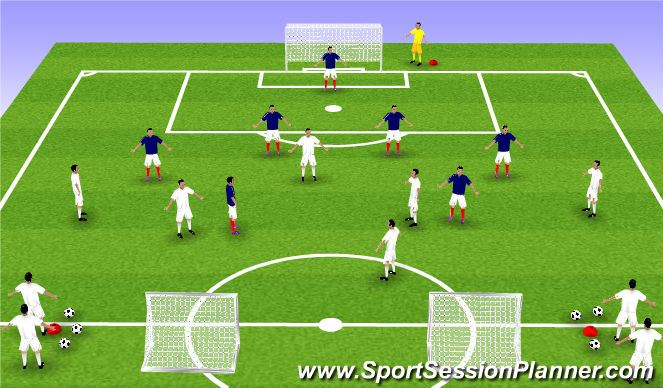
See the guidance at the top of this page to understand why you are not seeing interactive Football/Soccer images.

GRP (10 mins)
Game Related Practice
Organisation
Whites play 2 (fullbacks)-1-4-1 v 1-4-2 in the blues. Whites try to score in the big goal, blues in either of the smaller goals. Game starts with full back passing out.
Rotation / Progression
To begin with only one fullback joins in with attack, then both get involved.
Coaching Points
- Speed of attack, encourage positive forward passes
- Midfielders to drop deeper to create space for striker to drop into (3v2 in central midfield) - short passes in central area to bring opposition in arrow, then exploit wide areas
- How can we move the defenders? How can we get the defence to become detached? striker can attract central defenders towards him leaving gaps in behind for central mids/wide players, wide players can go high and wide to stretch defence and move fullbacks out / wide players can exchange passes with fullback to attract the oppositions fullback to touchline and leave 'channel' for striker to make blindside run into
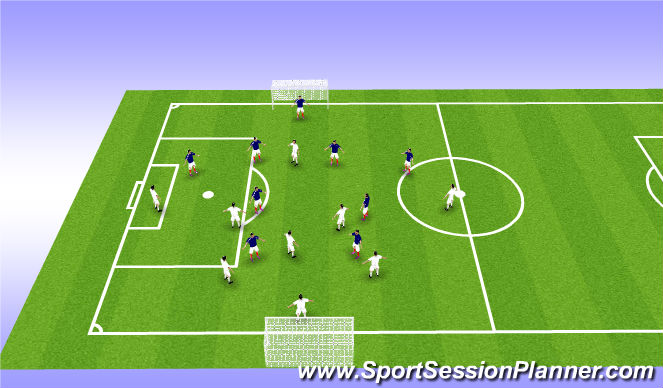
See the guidance at the top of this page to understand why you are not seeing interactive Football/Soccer images.

Conditioned Game (15 mins)
Conditioned Game
Organisation
Whites line up 1-2-1-4-1 against 1-4-2-2. Condition is all blues must be over halfway line for them to score. Take out condition after 10 mins and put blues on 10 seconds to score condition.
Coaching Points
- When first condition in play there should be space in behind. Talk about movement of striker, importance of staying on blindside of defender.
- Also speak to central midfielders about moving into space vacated by covering central defender (after penetrating runs from striker) and recognising these spaces opening up
- Importance of wide player staying high and wide to move fullbacks and create channels
When condition changes, blues may drop deeper;
- Strikers starting position (in between central defenders), timing of dropping off into space, on the half turn to see if able to turn; importance of midfielders indentifying that he can turn or not and adapt supporting / penetrating runs accordingly.
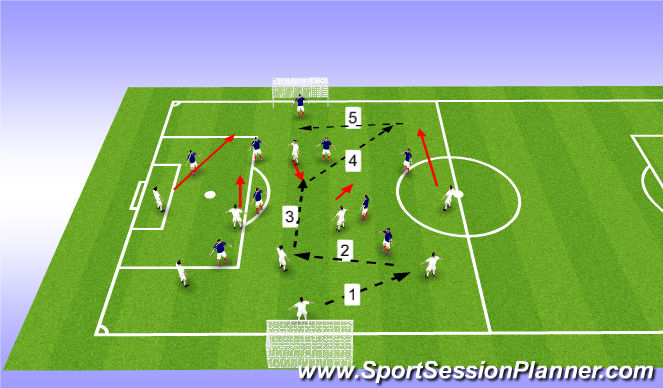
See the guidance at the top of this page to understand why you are not seeing interactive Football/Soccer images.

Option 1 -Striker drops off (unmarked) (5 mins)
Option 1
Striker drops off into space in front of defence and is allowed to turn. penetrating runs from two wide players and supporting runs from central midfielders, striker picks best option available.
Coaching Points
- striker to stay between central defenders initially
- timing of striker's movement to drop in and receive
- check shoulder (able to turn) and receive on the half turn
- timing and angle (straight / diagonal) of support runs (angle of wide players runs depends on which way striker turns)
- holding midfielder provides security against counter attack
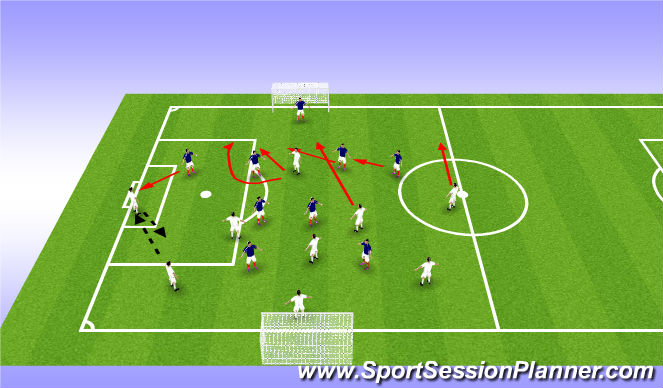
See the guidance at the top of this page to understand why you are not seeing interactive Football/Soccer images.

Option 2 - Striker channel run (5 mins)
Option 2
Attempting to move fullback to create channel for 'spin' run into channel. Full back exchanges pass with wide player to attract fullback to the touchline. Ball is returned to the fullback and he plays ball into the channel, striker makes blindside run to penetrate defensive line. Opposite central midfieder runs into the space created by covering central defender. Opposite wide player stays wide to try and influence fullbacks position.
'Coaching Points
- wide players go as wide as possible to create space (move fullback wide and create channel)
- wide player keeps possession to attract fullback towards him
- detail of pass back to set up firs time ball into channel
- striker positions himself on blindside of 'ball side' defender
- timing and angle of run in channel either across or in behind central defender
- run from opposite central midfielder into space vacated by covering central defender
- opposite wide player gives width
- Deepest midfielder offers protection against the counter attack.
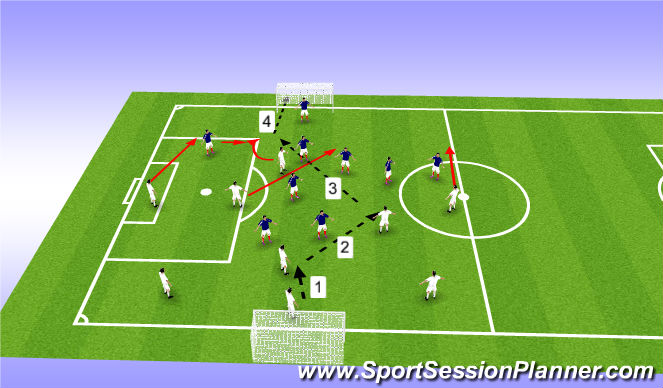
See the guidance at the top of this page to understand why you are not seeing interactive Football/Soccer images.

Option 3 Striker diagonal run (5 mins)
Option 3
Wide central midfieder in possession, defending team moves across, both wide players high and wide to move fullbacks. Centre forward moves onto the blindside of the second central defender to receive a pass in behind.
Coaching Points
- Team works the ball into central midfielder 'off the shoulder' and beyond opposite midfielder
- Closest wide player and opposite wide player go as high and wide as possible to mve fullbacks out.
- Striker firstly 'pins' furthest central defender to allow opposite central midfielder to make run across (to receive straight pass)
- Striker then drops in behind second central defender and in front of fullback to receive diagonal lofted pass
- If opposite fullback tucks in, switch of play is on
- Deepest midfielder protects against counter attack
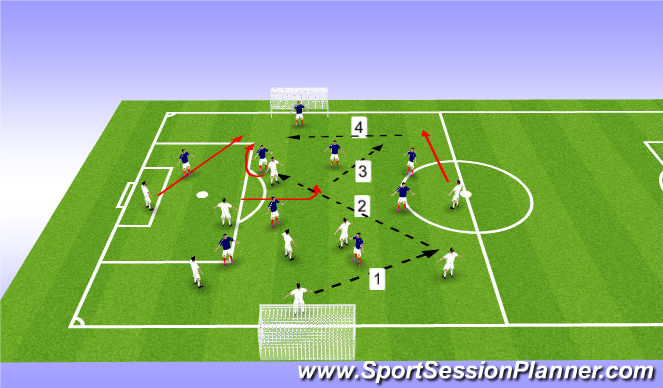
See the guidance at the top of this page to understand why you are not seeing interactive Football/Soccer images.

Option 4 - runner in behind (5 mins)
Option 4
Fullback plays into striker, who attracts defender to come with him. Striker 'pins' defender and lays off for midfielder making run across the front. Midfielder looks to play penetrating pass in behind. Striker spins to get into box along with opposite wide player and other central midfielder.
Alternative
Striker lays off to wide player and opposite central midfielder makes diagonal run into space vacated.
Coaching Points
- Midfielders movement to open up pass into striker
- Striker stays long then drops off into space in between the lines, second central defender follows
- Striker 'pins' second central defender
- timing and angle of run to support from midfielder
- weight and accuracy of lay off into midfielders path
- player in possession can play (straight pass / diagonal run) of wide player OR (diagonal pass / straight run) to opposite central midfielder depending on wher the remaining central defender goes.
- Opposite wide player high and wide to move fullback.







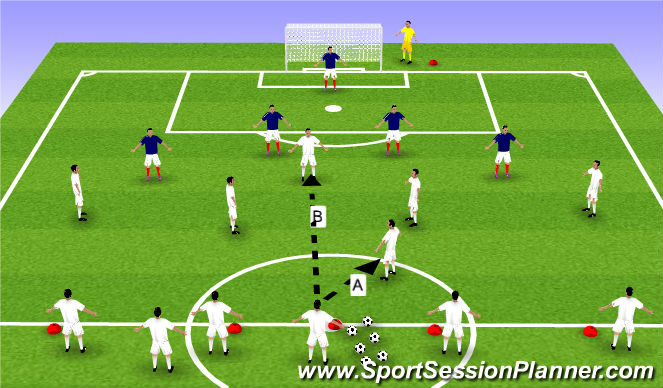
 Play animation
Play animation Play step-by-step
Play step-by-step Repeat (toggle)
Repeat (toggle) Full Screen
Full Screen Pause
Pause Stop
Stop
Drill (5 mins)
Drill - Waves of Attack
Organisation
Ball starts with white player who either plays into a midfielder or striker on the coach's request. Whites line up 1-4-1 against blues who have a goalkeeper and back four. Whites try to score in big goal, blues must clear to half way line. Whites encouraged to attack quickly to get an attempt on goal, if attacks are too slow bring in 12 second time limit to get attempt on goal.
Variations / Rotations
- First pass must go to midfield player
- First pass must go to striker
- Every two attacks, attacking six players swap over (and gks swap)
Coaching Points
- Speed of attack , try to play forward and be positive
- Penetration - How can we get behind the defence? who can run in behind? Where is the space? likely to be in wide areas - get wide players high and wide to try and penetrate quickly